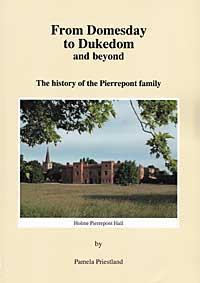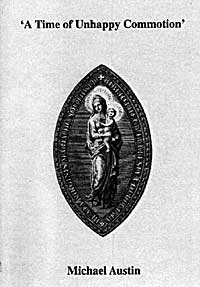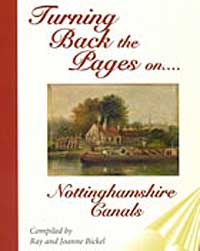Book reviews, Spring 2011
FROM DOMESDAY TO DUKEDOM and beyond - The history of the Pierrepont family. Pamela Priestland ISBN 978-1-872356-12-9 Published by Ash bracken, Radcliffe-on-Trent, 2010

This book is A4 sized with choice of hard or soft covers and is a hefty item of 464 pages. It is very well printed by a Nottingham firm of printers and has 370 illustrations, many in colour, a most useful Glossary, sources fully listed, each chapter referenced and a full index. Within the text are family trees and there are maps of places associated with the family.
The writing style is fluid but it is not the easiest of books to read because of the profusion of names although the family trees do help to follow the various family members' details. The book is very well researched with a great deal of detail included and it is very clear that this has been a labour of love on the part of the author.
The Pierreponts were a family of great influence in Nottinghamshire with large estate holdings in the county but they also had much influence in the Government of the country. There were strong ladies involved with them; a daughter whose broken marriage laid the way for modern divorce, another who introduced smallpox inoculation to Great Britain and a bigamous duchess. The sums of money talked about throughout the book are enormous as are the debts racked up from time to time.
The family is generally accepted as starting in Southern Picardy at the castle of Pierrepont, a name derived in the time of Charlemagne from an adjacent stone bridge. The family were supporters of William in 1066 with de Pierreponts fighting with William at the Battle of Hastings. In 1272 Henry Pierrepont married and his wife, Annora, brought with her lands around Holme (Pierrepont). The couple acquired much more land in Nottinghamshire. The Holme estate became known as Holme Pierrepont in the Tudor period. The author traces the family in great detail and, of course, they are inexorably linked with Thoresby and Holme Pierrepont. Much detail is provided about these two properties and their associated estates.
An excellent feature of this book for me, is that it includes information about how the family treated its tenants and ordinary workers, both those who worked in the houses and on the estates. Of necessity this information is not always available but it say much for the author's detailed research that she has included information where it is available, much, of course, from wills which are quoted in great detail. I frequently find myself much more interested in the ordinary folk of history than the gentry and aristocracy but such information is relatively little documented; from this book we can learn something about the conditions of ordinary people in our county.
This is an expensive book, but one which adds substantially to the history of Nottinghamshire, not only the Pierrepont aspects but also, through their relations with other great families of the area, of the county in general. In addition we gain an understanding of the way aristocratic families gained their titles, spent their money - often extravagantly on foreign travels - and generally lived their lives.
A book which is recommended reading for anyone with an interest in the people of the county, grand and less grand, but it is, as the title suggests, a history of a family. A grand family, a most important family of Nottinghamshire and one whose legacy to the present day still stands in two of the magnificent buildings of our county.
The book costs £25.00 in soft cover and £30 in hard cover plus £8.00 p&p from Ashbracken, 14 Cropwell Road, Radcliffe-on-Trent, Nottingham, NG12 2FS. Tel; 0115-933-2430 and email: neal@ashbracken.com. Cheques should be made payable to Radcliffe Local History Society.
Howard Fisher
A TIME OF UNHAPPY COMMOTION By Michael Austin - ISBN9-1-898937-75-3

This book by Canon Michael Austin, with what might appear to be rather a mysterious title, is a work of much scholarship which has involved the author in considerable research. As a one-time residentiary canon of Southwell
Minster, and with a copy of the Southwell Chapter Library bookplate on the front cover, one could wrongly assume that the contents might refer to mysterious shenanigans in the Minster itself.
Such a conclusion would be a serious mistake. The book, with a wealth of information from previously unused sources is concerned with the twenty-three parishes in the Rural Deanery of Southwell during the middle years of the nineteenth century. These parishes, which underwent a solemn 'visitation' in 1855, are used in meticulous detail by Michael Austin to demonstrate his thesis that what was happening in the Rural Deanery of Southwell was a small example of what was generally true in England as a whole at the time. (Full details of the visitation are included in the final section of the book).
During this period significant social changes were taking place in England and were having a profound effect upon the structure of society and particularly upon the relationship of Church and State. In its 250 pages, and the many footnotes and references on each page, the book examines in depth how the rapid transition from an agricultural based society to an industrial one during these years, from landed gentry control to more localized administration, from upper class dominated congregations to a wider social involvement, from pluralist and often absentee clergy to more dedicated and locally involved clergy gradually took place, and changed radically what had come to be taken for granted. The old order of society and accepted institutions and the concern for the poor and disadvantaged classes of society was stirring the conscience of those in charge.
The result of all this change was a situation where sparks could be seen to fly, where privilege was being questioned, and where the previously assumed stability of Church and State could no longer be assumed to be the norm for ever. The author seeks to demonstrate these changes and to lead the reader thoughtfully through the arguments, the discussions and the angst which such change produced. We see in detail the outspoken views and standpoint of significant figures such as George Wilkins (Archdeacon of Nottingham) and John Becher (Vicar General of Southwell). George Wilkins is quoted as saying 'the need to defend the rights and privileges of the Church of England by law established, and the need to protect it against zealous reformers'. John Becher, a magistrate and poor law reformer as well as Vicar General, for example, is described as 'that clergyman who plumes himself as being the despot of the town'.
In the cut and thrust of the material of Michael Austin's book we see the valiant efforts of the influential leaders of the Church of England struggling to protect what had been from what almost seemed to be about to overwhelm it. It was almost like King Cnut attempting to halt the flood of the incoming tide. Canon Austin covers what were controversial issues such as the local government of the local church, church rates, dissenters, family pews, church attendance, patronage, curates' salaries, Tractarian influences, the Church's involvement in education and its involvement in the care of the poor and disadvantaged in society, and the relationship between the squire and the parson. For George Wilkins the 'time of unhappy commotion' had developed because 'the objectionable influences of popular opinion has carried us out of the course of those high principles which ought to regulate our feelings and our teachings'.
The scope of Canon Austin's research is to be congratulated, and his work to present such a mass of information in a readable and understandable way will be appreciated by those who study the book.
Alan Langton
TURNING BACK THE PAGES ON NOTTINGHAMSHIRE CANALS Compiled by Ray and Joanne Bickel ISBN 978-0-902751-66-8

The topic chosen by Ray and Joan Bickel for their book is both interesting and timely: interesting because, although there have been other books dealing with local canals, this one deals with the subject in a more focused way; timely since its publication will precede a hopefully fruitful 'walking' season for the coming spring and summer. It is likely to be attractive to various groups of people such as walkers, photographers, nature lovers as well as, of course, the boating fraternity and local historians.
The brief history provided of each of the canals appears to give a good background although, without specific references, it is difficult to judge their accuracy. There is little doubt, however, that considering the detail included in all the other sections, one might assume that similar diligence was paid to the history sections.
The photographs included are, in the main, well reproduced, especially when one considers the age of many of them. In some cases there might have been some advantage in including more recent images since there appears to be none dated after 1989, with the majority considerably earlier.
Also, it might have been advantageous to include maps with a little more detail so that some correlation between the photographs and the actual locations would have provided assistance to those unfamiliar with the area, but these omissions do not seriously detract from the overall work.
The journeys on which the reader is taken along the various canals are well presented and form a logical route with useful notes along the way. For instance, the section on the Nottingham canal provides good information to assist the reader in tracing their way through the route. The information provided will certainly assist in avoiding the missing sections. It also draws interesting comparisons between the past and present canal side buildings and other 'furniture'. It comes as something of a surprise to discover the size of some of the sailing barges that used the canal in the nineteenth century and this, together with the details of the area from the River Trent to the Lenton district, could be of significant interest to the historian. One boat of particular interest is the 'Francesca', Trevithick's pleasure steamer that operated along the canal to Trent Lock from 1903 until the outbreak of the First World War.
Similar benefits can be found in the sections on the other canals dealt with by the authors. There are many examples of areas of significant interest and, although rather small in scale, the maps provided allow the reader to traverse the waterways from the comfort of an armchair. These descriptions do, though, provide an incentive to leave the comfort of the chair and plan and execute walks along each of the routes.
This book is a very pleasing publication and will aid the enjoyment of the many people who either tramp or navigate the waterways, whatever their motivation for so doing. It may also provide a spark of enthusiasm for those not yet converted to the delights of the various canals in the Nottinghamshire system.
The book can be purchased from all the major libraries in the county and from the Nottinghamshire Archives, or by post by sending a cheque for £ 10.50 which includes the £3.00 p&p cost, payable to Nottinghamshire County Council from Libraries, Archives and Information, Communities Department, 4th Floor, County Hall, West Bridgford, Nottingham, NG2 7QP.
Alan Butler